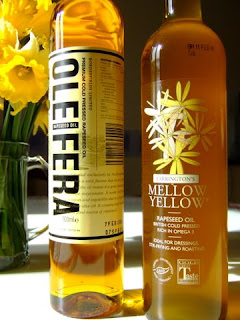
Stand by for two things. The first is the explosion of acid yellow rapeseed flowers that will dazzle the eyes in fields across the country in early summer. The second is the explosion of locally grown, cold pressed rapeseed oil that is going to migrate from the plastic bottles on the bottom shelf to the fancy bottles on the top shelf, where the olive oil sits.
We’ve been growing rapeseed in this country for years, thanks to EEC subsidies, and the EU interest in biofuels is going to see to it that those glaring fields of yellow continue to shock. I don’t mind them; they put me in mind of French impressionists and I quite like the scent although I believe it gives some people a headache. All the oilseed rape grown in the UK is GM free, which is nice, but I bet you didn’t know that 85-95% of it goes into the food chain. And most of the stuff in plastic bottles that is labelled ‘vegetable oil’ is actually rapeseed oil. I don’t think I would like to know about the processes the large scale manufacturers use to recover the oil, but then I wouldn’t like to know about what they do to make ordinary olive oil either.
No. We are now talking about a high end product. Cold pressed, low in saturated fat, ten times more Omega 3 than olive oil, and a natural source of Vitamin E, rapeseed oil is locally produced in an increasing number of locations in the UK. Arable farmers who previously took little interest in what happened to their product are now keenly aware of consumers’ concerns about food miles and a market has opened up. I sampled oil from two producers; Mellow Yellow from Farringtons in Northants, and Oleifera from right up in Northumberland, on the Scottish borders.

Mellow Yellow is a virgin cold pressed oil with an unfiltered cloudy look in the bottle. Grown by Duncan Farrington on his LEAF marque farm (Linking Environment And Farming) it is one of the leaders in this new move from commodity product to a competitor to olive oil. The seeds are planted in August and the pods are harvested at the end of July. You can plant a variety of rape in the spring, but it tends to have a bitter taste. The seeds are pressed gently, at temperatures which never rise above 31ºC, thereby retaining all the health giving properties.
 Oleifera, in its elegant tall bottle which won’t fit into my cupboard, is clear and bright golden. Grown by a group of farmers in the borders the crop seems to like the climate and thrives. It settles naturally to give a bright sparkling oil which, aside from all its healthy properties, has a high burning point of around 230ºC, making it ideal for frying and for roast potatoes to which it imparts its wonderful golden colour. From first pressing to bottling takes about six weeks and if you’re wondering about the name – Oleifera is latin for ‘oil-bearing seed’, and as the Romans brought the seed to Britain it is an appropriate name.
Oleifera, in its elegant tall bottle which won’t fit into my cupboard, is clear and bright golden. Grown by a group of farmers in the borders the crop seems to like the climate and thrives. It settles naturally to give a bright sparkling oil which, aside from all its healthy properties, has a high burning point of around 230ºC, making it ideal for frying and for roast potatoes to which it imparts its wonderful golden colour. From first pressing to bottling takes about six weeks and if you’re wondering about the name – Oleifera is latin for ‘oil-bearing seed’, and as the Romans brought the seed to Britain it is an appropriate name.
So – what does it taste like? Both oils look bright and clean, with the Oleifera bright in the bottle and Mellow Yellow cloudy and unfiltered – good in my book. Mellow Yellow has a bit more scent than Oleifera when you sniff it. When I tasted the Oleifera my first thought was ‘buttery’. It has a warm, clean taste, very light and with a trace of sweetness. Mellow Yellow – my first thought was ‘new mown hay’. A definite but quite pleasant vegetal taste, sweet and clean. Both producers describe their product as having a ‘nutty’ taste, but when I think ‘nutty’ I think of walnuts and hazelnuts and there is no comparison.
But if, like me, you really like olive oil, I think you will be disappointed. The complexity of olive oil, the pepper, the hit at the back of the throat, the bitterness or lack of it, the acid freshness green or golden, those notes are absent. I don’t honestly think you could offer your guests a pool of rapeseed oil to dandle their bread in and expect coos of delight.
But, on the other hand, you know how cook books are always telling you not to use your best olive oil for such and a thing, and you end up using your best olive oil because you only have one bottle? Well, for roasting potatoes instead of goose fat, for massaging the roast chicken before it goes into the oven, for mayonnaise when you don’t want the strength of the olive flavour to dominate, and for a light salad dressing – this will be ideal. And it hasn’t travelled very far to get to you.

 This time the stallholders were handpicked by an advisory team with impressive credentials, and attendance was subsidised. You can tell immediately if the person on the other side of the stall has had any involvement in the production of the thing they are selling, and these people were there in abundance.
This time the stallholders were handpicked by an advisory team with impressive credentials, and attendance was subsidised. You can tell immediately if the person on the other side of the stall has had any involvement in the production of the thing they are selling, and these people were there in abundance. There were Master Classes from chefs like Barney Haughton from Bordeaux Quay in
There were Master Classes from chefs like Barney Haughton from Bordeaux Quay in  And with all that free tasting the people who were there to sell snacks may have felt a bit left out. Four days of festival and a setting up day means that people were away from their businesses for a long time and the first couple of days were badly attended. I think a lot of producers may stay away next year, which will be a pity as the advance publicity will be better. But the quality really was good and that is something that the more regional festivals could learn from.
And with all that free tasting the people who were there to sell snacks may have felt a bit left out. Four days of festival and a setting up day means that people were away from their businesses for a long time and the first couple of days were badly attended. I think a lot of producers may stay away next year, which will be a pity as the advance publicity will be better. But the quality really was good and that is something that the more regional festivals could learn from.





